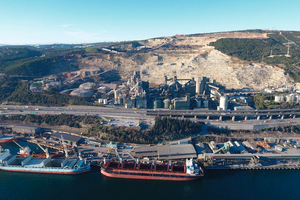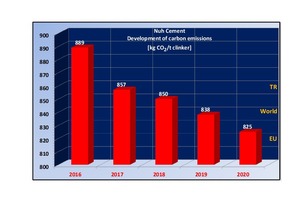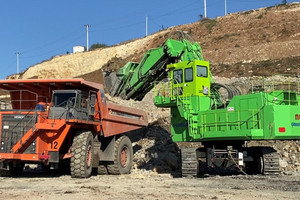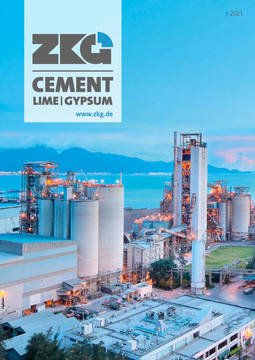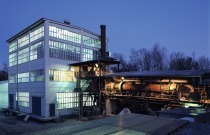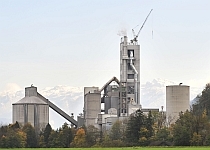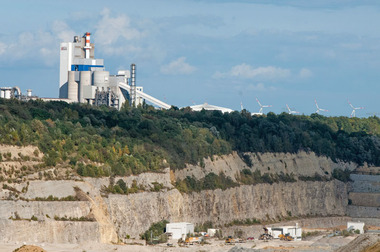Nuh’s journey towards total
carbon dioxide neutrality
Cement production emits a considerable amount of greenhouse gases due to the intense use of energy and the very nature of the calcination reactions. This situation has led the industry to make continuous improvements to consume less energy and maintain a sustainable future. Moreover, environmental disasters experienced across the globe increase the responsibility of all sectors and prepare the ground for establishing a mechanism for the reduction of CO2 emissions.
Turkey is responsible for 1.1% of the total global CO2 emissions whereas the Turkish Cement industry is responsible for 12% of the total CO2 emissions of Turkey.
Since its inception in 1966, Nuh Cement not only reached 4.4 million clinker production capacity but also constantly worked hard to be at the forefront of technological advancement.
Over the years, many cutting-edge technologies and products have been taken into operation at Nuh Cement such as:
introduction of highly-blended cement types in place of clinker-intensive CEM I type
the largest waste heat recovery plant (20 MW) of Turkey
the largest cement mill (408 t/h acc. 4000 Blaine)
high-efficiency clinker coolers
electrified heavy mining equipment capable of excavating 3.5 million t of blasted rock annually
All these cutting-edge technologies not only improved efficiency but also reduced carbon dioxide emissions, which are well proved and documented through real-life field data.
Nuh Cement initiated the carbon dioxide emissions calculation process in 2015 and the whole process has been constantly verified by a third party.
As a natural consequence of the cutting-edge technologies, the carbon dioxide emission of Nuh Cement has dropped drastically over a five year period.
The carbon dioxide emission of 2016 was measured as 889 kg CO2 per t of clinker produced. In 2020 the carbon dioxide emission had dropped to 825 kg CO2 per t of clinker produced. In only five years, Nuh Cement has managed to lower its carbon dioxide emission below the Turkish Cement Industry average (852 kg CO2 per t clinker) and the Global Cement Industry average (836 kg CO2 per t clinker). The next carbon dioxide emissions target is to match the EU Cement Industry average of 815 kg CO2 per t clinker.
The total carbon dioxide emissions of a typical cement factory come from:
1. Mining equipment and transportation of raw material
2. Combustion of fossil fuel consumed in clinker making
3. Calcination of raw material
4. Electricity consumption from crushers up to cement mills
However, the aforementioned carbon dioxide emission figures include only the sum of item 2 and item 3. Since this is the current established carbon dioxide emission norm accepted by the industry, Nuh Cement will keep reporting this figure. But Nuh Cement’s carbon neutrality project encompasses all four items and aims to reduce all aspects of carbon dioxide emissions. And this is why it is called the “Total Carbon Dioxide Neutrality Project”.
Not only the new technologies which are already in operation but also the introduction of highly-blended cement types (CEM II BS and the like) into the market played a major role in reducing Nuh Cement’s total carbon dioxide emission. The role of blended cement types in carbon dioxide emission reduction can not be emphasized more. Since clinker is the major source of carbon dioxide emission, cement types that contain less clinker will eventually emit less.
However, the introduction of blended cement types has its own challenges such as assuring ready-mix concrete customers for CEM I the equivalent performance of the blended cement types. After five years of hard work, the quality and process department of Nuh Cement managed to convince ready-mix concrete customers in favor of highly-blended cement types.
In five years’ time, Nuh Cement has reduced CEM I production, which has a clinker content of around 92%, from 90% of total domestic sales down to a staggering 9% of total domestic sales. As of 2021, domestic cement sales are mainly composed of CEM II AS (83% clinker content) and CEM II BS (70% clinker content).
What is next?
Despite all the efforts to enhance process efficiency and lower carbon dioxide emissions, Nuh’s journey towards total carbon dioxide neutrality is far from over.
In order to further decrease carbon dioxide emission, the technical team is working on several state-of-the-art projects to be implemented in the coming months, namely:
calcinator modification for increasing RDF, SRF, and petcoke utilization
clinker cooler modification for decreasing specific energy of clinker production
hydrogen gas production from kiln exhaust gas mixture
calcined clay production and inclusion in the cement production
waste heat boiler modifications for increasing waste heat recovery plant electricity production
captive power generation through wind turbines to be erected at the cement factory premises
conversion of 100-ton class off-highway diesel trucks to battery-operated electric trucks
Calcinator modification of the existing three kilns will enable Nuh Cement to increase RDF, SRF, and waste tire utilization by 40% whereas petcoke utilization may reach 100%.
This modification will translate into an annual steam coal reduction of 110000 t or in other words 100000 t of CO2 reduction annually. Upon successful completion of the project, Nuh Cement’s current carbon dioxide emission level of 825 kg CO2 per ton of clinker produced will be lowered to around 802 kg CO2 per ton of clinker produced, which is lower than the current EU cement industry average.
Unburnt fuel at the kiln exhaust gas appears as CO and a brand new technology is being investigated to convert CO into hydrogen gas. Once hydrogen is produced, the current plan is to convert it into electricity at the waste heat recovery plant.
Calcined clay production technologies and the suitability of nearby clays are being looked into at the Nuh Cement Quality Control department. The estimated impact on carbon dioxide emission of cement may be well over 200000 t of CO2.
Increasing the specific energy efficiency of clinker production translates into an increase in the waste heat which in turn is converted into electricity at the existing waste heat recovery plant.
Annual electricity consumption at Nuh Cement is around 570 GWh of which 120 GWh (64000 t of CO2 reduction) is produced on-site at the waste heat recovery plant. Another 180 GWh (96300 t of CO2 reduction) is planned to be generated through the wind turbines to be commissioned within the factory area. All-in-all, 300 GWh of electricity which equates to 52% of the total annual electricity consumption will be produced on-site from all-green sources.
Another pioneering project is the conversion of existing 100-ton class off-highway diesel trucks to battery-operated electric trucks. The project is a continuation of the all-electric mining equipment project that has been operational since 2018. So far almost all excavators have been converted to all-electric, crossing the 1200000 l of diesel fuel savings line as of June 2021. Once the dump trucks are converted, annual savings of transport diesel fuel will be around 900000 l.
The only way ahead
The journey towards total carbon dioxide neutrality will no doubt be a bumpy ride. The very basics of cement production are an intensively carbon dioxide emitting process and the ways and means to lower the carbon dioxide emissions is a very difficult task that requires out-of-the-box thinking together with the implementation of state-of-the-art technologies. Yet it is the only and the ultimate way for the survival of the cement industry.

